
Pyramorphix
Encyclopedia
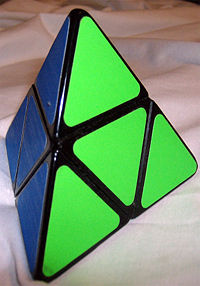
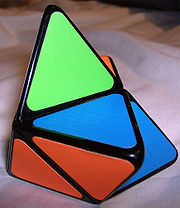
Tetrahedron
In geometry, a tetrahedron is a polyhedron composed of four triangular faces, three of which meet at each vertex. A regular tetrahedron is one in which the four triangles are regular, or "equilateral", and is one of the Platonic solids...
puzzle similar to the Rubik's Cube
Rubik's Cube
Rubik's Cube is a 3-D mechanical puzzle invented in 1974 by Hungarian sculptor and professor of architecture Ernő Rubik.Originally called the "Magic Cube", the puzzle was licensed by Rubik to be sold by Ideal Toy Corp. in 1980 and won the German Game of the Year special award for Best Puzzle that...
. It has a total of 8 movable pieces to rearrange, compared to the 20 of the Rubik's cube. Though it looks like a simpler version of the Pyraminx
Pyraminx
The Pyraminx is a tetrahedral puzzle similar to the Rubik's Cube. It was invented and patented by Uwe Meffert, and introduced by Tomy Toys of Japan in 1981. Meffert continues to sell it in his toy shop, ....
, it is an edge-turning puzzle with the mechanism identical to that of the Pocket Cube
Pocket Cube
The Pocket Cube is the 2×2×2 equivalent of a Rubik's Cube. The cube consists of 8 pieces, all corners.-Permutations:...
.
Description
At first glance, the Pyramorphix appears to be a trivial puzzle. It resembles the Pyraminx, and its appearance would suggest that only the four corners could be rotated. In fact, the puzzle is a specially shaped 2×2×2 cube. Four of the cube's corners are reshaped into pyramids and the other four are reshaped into triangles. The result of this is a puzzle that changes shape as it is turned.The purpose of the puzzle is to scramble the colors and the shape, and then restore it to its original state of being a tetrahedron with one color per face.
Number of combinations
The puzzle is available either with stickers or plastic tiles on the faces. Both have a ribbed appearance, giving a visible orientation to the flat pieces. This results in 3,674,160 combinations, the same as the 2×2×2 cube.However, if there were no means of identifying the orientation of those pieces, the number of combinations would be reduced. There would be 8! ways to arrange the pieces, divided by 24 to account for the lack of center pieces, and there would be 34 ways to rotate the four pyramidal pieces.

The Pyramorphix can be rotated around three axes by multiples of 90°. The corners cannot rotate individually as on the Pyraminx. The Pyramorphix rotates in a way that changes the position of center pieces not only with other center pieces but also with corner pieces, leading to a variety of shapes.
Master Pyramorphix

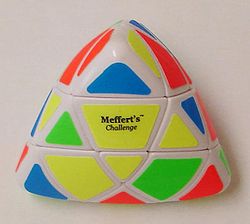

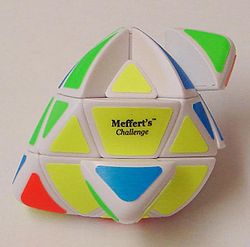
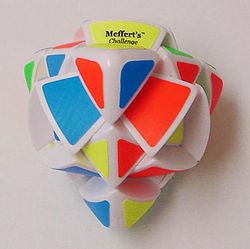
Uwe Mèffert
Uwe Mèffert has manufactured and sold mechanical puzzles in the style of Rubik's Cube since the original Cube craze. His first design was the Pyraminx and others include the Megaminx, Skewb and Skewb Diamond...
's commercially-produced pillowed variant (pictured), sold through his puzzle shop Meffert's.
The puzzle consists of 4 corner pieces, 4 face centers, 6 edge pieces, and 12 non-center face pieces. Being an edge-turning puzzle, the edge pieces only rotate in-place, while the rest of the pieces can be permuted. The face centers and corner pieces are interchangeable, and the non-center face pieces may be flipped, leading to a wide variety of exotic shapes as the puzzle is twisted. If only 180° turns are made, it is possible to scramble only the colors while retaining the puzzle's tetrahedral shape.
In spite of superficial similarities, the puzzle is not related to the Pyraminx
Pyraminx
The Pyraminx is a tetrahedral puzzle similar to the Rubik's Cube. It was invented and patented by Uwe Meffert, and introduced by Tomy Toys of Japan in 1981. Meffert continues to sell it in his toy shop, ....
, which is a face-turning puzzle. The corner pieces are non-trivial; they cannot be simply rotated in-place to the right orientation.
Solutions
Despite its appearance, the puzzle is in fact equivalent to a shape modification of the original 3x3x3 Rubik's Cube. Its 4 corner pieces and 4 face centers together are equivalent to the 8 corner pieces of the Rubik's Cube, its 6 edge pieces are equivalent to the face centers of the Rubik's Cube, and its non-center face pieces are equivalent to the edge pieces of the Rubik's Cube. Thus, the same methods used to solve the Rubik's Cube may be used to solve the Master Pyramorphix, with a few minor differences: the edge pieces are sensitive to orientation, unlike the usual coloring scheme used for the Rubik's Cube, and the face centers are not sensitive to orientation. In effect, it behaves as a Rubik's Cube with a non-standard coloring scheme where face-center orientation matters, and the orientation of 4 of the 8 corner pieces do not matter.Unlike the Square One
Square one (puzzle)
The Square One, also known as Back to Square One and Cube 21, is a puzzle similar to the Rubik's Cube. Its distinguishing feature among the numerous Rubik's Cube variants is that it can change shape as it is twisted, due to the way it is cut, thus adding an extra level of challenge and difficulty...
, another shape-changing puzzle, the most straightforward solutions of the Master Pyramorphix do not involve first restoring the tetrahedral shape of the puzzle and then restoring the colors; most of the algorithms carried over from the 3x3x3 Rubik's Cube translate to shape-changing permutations of the Master Pyramorphix. Some methods, such as the equivalent of Phillip Marshal's Ultimate Solution, show a gradual progression in shape as the solution progresses; first the non-center face pieces are put into place, resulting in a partial restoration of the tetrahedral shape except at the face centers and corners, and then the complete restoration of tetrahedral shape as the face centers and corners are solved.
Number of combinations
There are four corners and four face centers. These may be interchanged with each other in 8! different ways. There are 37 ways for these pieces to be oriented, since the orientation of the last piece depends on the preceding seven, and the texture of the stickers makes the face center orientation visible. There are twelve non-central face pieces. These can be flipped in 211 ways and there are 12!/2 ways to arrange them. The three pieces of a given color are distinguishable due to the texture of the stickers. There are six edge pieces which are fixed in position relative to one another, each of which has four possible orientations. If the puzzle is solved apart from these pieces, the number of edge twists will always be even, making 46/2 possibilities for these pieces.
The full number is 88 580 102 706 155 225 088 000.
However, if the stickers were smooth the number of combinations would be reduced. There would be 34 ways for the corners to be oriented, but the face centers would not have visible orientations. The three non-central face pieces of a given color would be indistinguishable. Since there are six ways to arrange the three pieces of the same color and there are four colors, there would be 211×12!/64 possibilities for these pieces.

The full number is 5 062 877 383 753 728 000.
See also
- Rubik's CubeRubik's CubeRubik's Cube is a 3-D mechanical puzzle invented in 1974 by Hungarian sculptor and professor of architecture Ernő Rubik.Originally called the "Magic Cube", the puzzle was licensed by Rubik to be sold by Ideal Toy Corp. in 1980 and won the German Game of the Year special award for Best Puzzle that...
- PyraminxPyraminxThe Pyraminx is a tetrahedral puzzle similar to the Rubik's Cube. It was invented and patented by Uwe Meffert, and introduced by Tomy Toys of Japan in 1981. Meffert continues to sell it in his toy shop, ....
- Skewb DiamondSkewb DiamondThe Skewb Diamond is an octahedron-shaped puzzle similar to the Rubik's Cube. It has 14 movable pieces which can be rearranged in a total of 138,240 possible combinations. This puzzle is the dual polyhedron of the Skewb.- Description :...
- Pocket CubePocket CubeThe Pocket Cube is the 2×2×2 equivalent of a Rubik's Cube. The cube consists of 8 pieces, all corners.-Permutations:...
- Combination puzzlesCombination puzzlesA combination puzzle, also known as a sequential move puzzle, is a puzzle which consists of a set of pieces which can be manipulated into different combinations by a group of operations. The puzzle is solved by achieving a particular combination starting from a random combination...
- Mechanical puzzles

